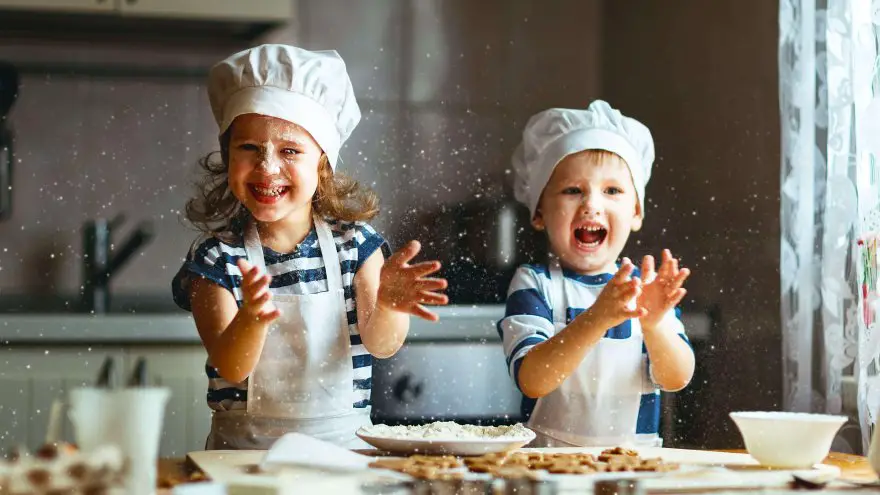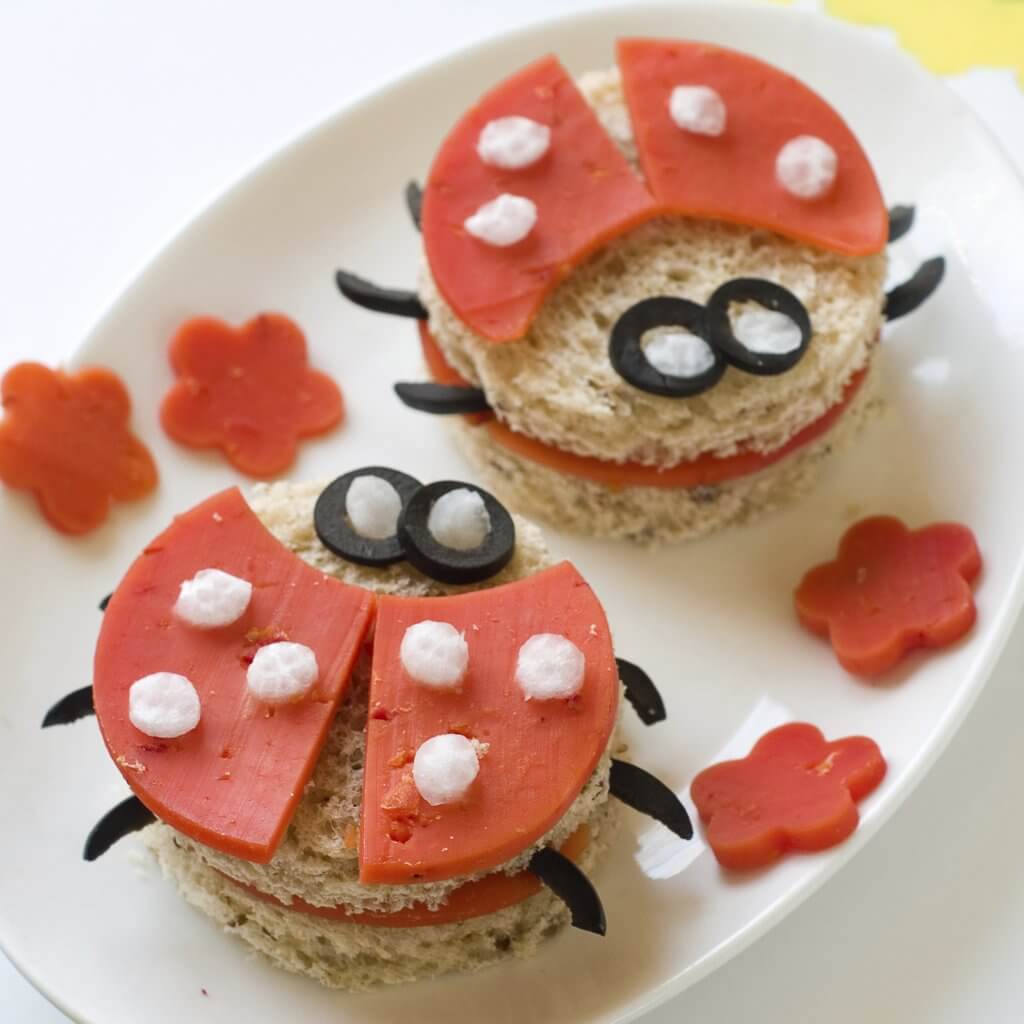The Essentials of Teaching Your Kids How to Cook

You’re never too old to learn to cook, but starting at an early age isn’t a bad idea either. Preparing food and understanding nutrition is a valuable skill with lifelong benefits, and the act of teaching your children how to thrive in the kitchen can be a wonderful bonding experience. Still, the clean up and prep can be daunting, not to mention safety concerns and, for some, the hurdle of convincing your kids that cooking can be fun instead of a chore. Here you’ll find some tips to minimize stress surrounding at-home cooking lessons, and hopefully some fun ideas to entice all age groups.
Safety First
The kitchen should always feel like a fun and safe place to learn and experiment, so make sure you’ve placed dangerous objects out of reach and instill some rules before you begin to avoid any accidents.
Wash your hands before and after touching food
There are certain foods that we all need to wash our hands immediately after handling, such as raw meats, poultry, seafood and eggs. Additionally, when working with spicier ingredients, be sure that children wash their hands right away, particularly if they are prone to rubbing their eyes.
Listen to the adults helping you
Especially as your children start handling knives and heat in their recipes, they’ll need some guidance. Be sure to keep a close eye on them and stress the importance of active listening when working together with sharp tools or extreme temperatures. Constant, attentive supervision is necessary as these elements are introduced and explored. Start younger children with plastic butter knives on projects that don’t require heavy chopping. (Soft fruits or steamed vegetables and basic white sandwich breads are usually easy to cut without a heavily sharpened knife. Additionally you might begin them by using those plastic knives to spread condiments so that they might get used to the responsibility of a knife before adding any pressure to it.)
Follow Your Recipe
A recipe’s instructions are there to set us up for success. Impart upon your children the reasons why we read them carefully and follow them closely–both for safety and to make sure that our food turns out well. Cooking and especially baking involve a great deal of science. If your child takes a special interest in that subject, play to their passions. And if they don’t find it particularly engaging, cooking is a great tool to show them the ways in which science applies to our daily lives. (There are plenty of handy books available through Amazon with both recipes and fun facts if you’re looking for a starting guide.)
No Secret Taste Tests
Eating certain raw foods can result in consequences ranging from simple (but uncomfortable) indigestion to nasty food-borne illnesses. Explain to your kids which foods they can’t nibble off of while raw, especially right before beginning a recipe involving any of them. To be safe, they should always ask before sneaking a taste of an in-progress recipe.
Beginning Skills

For our youngest chefs, it can feel hard to find tasks that won’t result in mess or injury. Here are some easy go-to steps in most recipes which you can use to make sure your little one feels included and helpful.
Gathering ingredients
Gathering ingredients is a great way to help them learn the names of food, especially the many different kinds of fruits and vegetables. As they get older, you can also start helping them take note of established patterns in recipes. Ask them questions to help them form these ideas for themselves: which ingredients usually go together? Is it because they taste good? Are there any other reasons? Which foods do you think it would be silly to mix?
Scooping ingredients with a measuring cup
For wet or messy ingredients, keep a closer eye, but dry ingredients require less supervision. Help your child to distinguish between the different sizes in measuring cups for themselves, and match them up to what the recipe calls for.
Adding pre-measured ingredients into mixing bowls
If that becomes too much clean up, another option is to measure out the ingredients yourself and assist your child in adding them one by one to the recipe. For very beginners, try starting with simple dry ingredients such as chocolate chips, nuts, or raisins that they can sprinkle into something mostly-finished like cookies or brownies.
Decorating
Some of the greatest fun in cooking is the creativity we get to exercise in the kitchen. Bake some treats and set up a station to decorate together. Avoid small decorations that might be choking hazards with toddlers. Frosting can be messy, so lay down a sheet of parchment paper or some old newspaper you can throw out rather than having to scrub down the table or counters again.
Stirring
If your child has any kind of toy kitchen set, this is probably already an action they’re used to mimicking. For the exuberant tykes, try smaller portions in larger bowls, eliminating splash-back.
Washing fruits and vegetables
The preparation that happens before beginning a recipe is often just as arduous and important as the cooking itself. Make this fun by grabbing the step-stool (if your child still needs one) and washing the produce together. (Plus, you’re technically tricking them into washing their own hands again, which is a good idea more often than not.)
Helping to set the table
Once the meal is finished, there’s the added bonus of getting to enjoy it with the ones you love. Teach your child respect for shared responsibilities and the importance of family time by having them assist in setting the table.
Simple Recipe Ideas
No or very little prep for adults, minimal to no interaction with heat or knives for kids: here are your fun, simple staples if you’re too busy for extensive prep/clean up or if you’re working with children who aren’t yet old enough to assist with chopping and heating.
- Pasta: Kids can measure and add the water to the pots, then stir the sauce in once it has cooled.
- Break and Bake cookies: Kids can help tear the dough apart, grease the pan with the butter, line the dough up on the sheet, and decorate once the cookies are cooled.
- Salads: Kids can gather the vegetables, wash them, mix them and dress them. If you’re short on time, try buying pre-cut vegetables that they can count off/measure and add so no one has to do any prep.
- Popsicles: Kids can pour their favorite juices or mix a few if everyone is feeling creative; there are plenty of fun ice trays in different shapes to try out. Pop the stick into the bottom and let them freeze.
- Smoothies: Make sure to keep blades away from little hands; Magic Bullet has a separate fixture with the blade on it so young ones can portion out and pour their own single-serving smoothies or milkshakes into cups and adults can handle the sharp bits.
- Peanut Butter and Jelly Sandwiches: Kids can use a dull plastic knife or a spoon to spread condiments if you’re concerned about safety.
- Pizza: You can buy premade dough, raw or cooked, and your children can add ingredients to the top. Help them decide what might taste good together and have ingredients sectioned in little bowls for them to choose from.
- Sandwiches: Adults can chop any veggies and put into tupperware to use throughout week, or buy mostly pre-sliced options such as deli meat; kids can help choose their ingredients and assemble their sandwiches.
Intermediate/Advanced Recipe Ideas
Some prep for adults, some interaction with heat or knives for kids: these ideas are classics for children with a little experience under their belt.
- Scrambled Eggs: Kids can learn to break eggs, stir with milk and seasoning, and prep the pan with grease. Older kids can help scramble the eggs on the stove as well.
- Cookies (from scratch): Kids can help mix ingredients, roll out the dough, use cookie cutters for fun shapes, prep for oven, and decorate at the end. This is a great place to start teaching about handling food and heat. Don’t forget the oven mitts!
- Brownies (scratch or boxed): Brownies from scratch take a little more time and preparation so if you’re feeling ambitious, have at it! There’s no shame in a good boxed brownie though, which is easy enough that kids might be able to start doing it all on their own from start to finish.
- Baked Tofu Tenders: Fun, easy and vegetarian! The only chopping necessary is the tofu, which is relatively easy and thus a great opportunity to introduce your children to using knives (with supervision, of course). Quick and not too diverse in its call for ingredients, so it won’t require much clean up or a long shopping list either. A quick google search will yield plenty of ways to prepare and season.
- Chicken Marinade: Once your child is ready to start handling raw meat, marinades are a great place to start. Mixing them only requires a few ingredients at a time, and if there’s any chopping it tends to be garlic, so chop a few cloves at once and keep them on hand. The raw meat doesn’t need any complicated handling either, so children can manage it when they’re still just starting out. If you’re into prepping the week’s meals ahead of time, this allows for some variety while still being fairly simple. Teriyaki, Lemon Herb, Tex Mex, Apple Mustard–pick your favorites and hop to it.
Themed Snacks

Finally, if you’re having trouble engaging your young ones in the kitchen, try appealing to other topics that they love. Below are some themed snack ideas based on popular children’s shows, all of which are easy and fast. A quick pinterest search will yield lots of options for most children’s media.
- Peppa Pig – Grandpa Pig’s Vegetable Garden: You can decide on the level of difficulty for this one. If you want to take it easy, just chop or buy a variety of pre-chopped vegetables and some hummus. (If you’re feeling extra fancy, grab a few different flavors of hummus too.) In small cups or bowls, spoon out the hummus and place a few veggies in each like dirt mounds, then arrange them however you’d like to make your garden. If you have some extra time, you can make the hummus from scratch using a food processor. Google basic recipes to see what kind of flare other home-chefs like to add.
- Paw Patrol – Puppy Chow: This recipe calls for a little stove-work so either do this with your more experienced young chefs, or be prepared to take care of part of the process yourself while they watch and cheer you on. Puppy chow is a fun, sweet treat that can be bagged and brought in lunch boxes for days to come, or stored in a jar in the kitchen.
- Doc McStuffins – Quick and easy, you can melt some white chocolate in a pan and you and your child can dip both ends of thin pretzel sticks into them to create Q-Tips for the animals’ check ups. Alternately you can use marshmallows to avoid having to heat anything.
- Superhero snacks – Thor Hammers: Cut a block of cheese into small cubes (try for short rectangles rather than perfect squares) and stick thin pretzel sticks into the center to make mini Thor Hammers with your favorite little superhero.
The Joy of Cooking
Learning to cook can be a lifelong endeavor and it takes time to cultivate some of these skills. Make sure to encourage your little ones with love and support, and to remind them that sometimes trial and error is part of the process. As long as they are spending time with you and getting a chance to express themselves, everyone is doing it just right.







